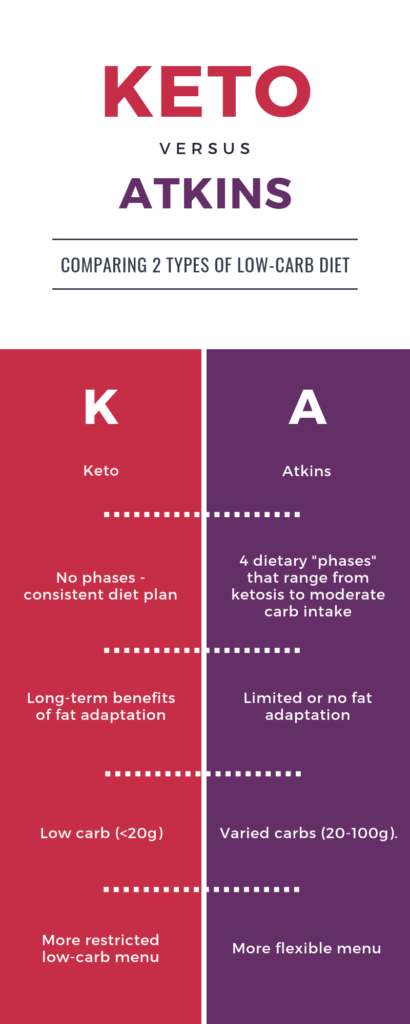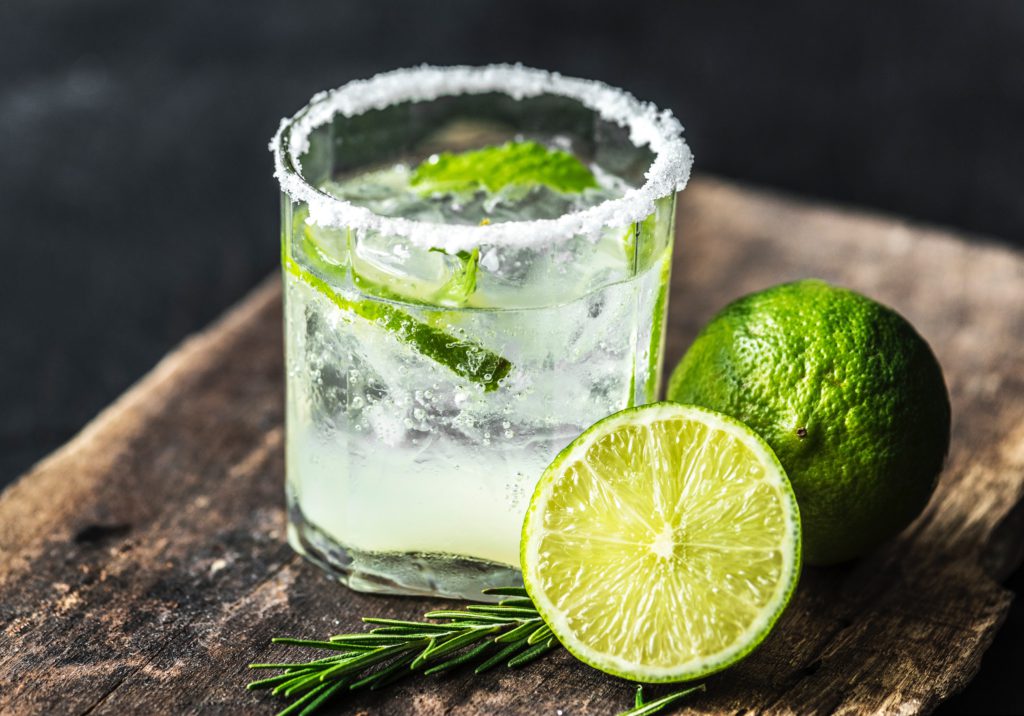Low-carb high-fat (LCHF) diets are powerful tools for fast and efficient weight loss. Though many variations of LCHF diets exist, two of the most popular forms are the Atkins diet and the keto diet. Though at first glance these diets may seem fairly similar, there are some important differences between keto and Atkins. Both diets have many of the same food restrictions and the end goal is essentially the same – to lose weight by getting your body into a state of metabolic ketosis. However, the role that ketosis plays in both diets varies quite a bit. So, what is the difference between keto and Atkins?
The Short Answer
The goal of a traditional keto diet is to maintain a state of indefinite metabolic ketosis. In the Atkins diet, achieving ketosis is the first of four dietary “phases”. The Atkins diet eventually transitions from metabolic ketosis to a balanced diet that includes healthy carbohydrates.
To put it another way, in a traditional keto diet ketosis acts as a long term partner in the fat burning process; in the Atkins diet, ketosis is more of a short term achievement that is phased out over time.
The keto diet has gained tremendous popularity in recent years. In addition to being a less complicated diet plan than Atkins, the long-term effects of metabolic ketosis can be very positive. After prolonged ketosis, some keto dieters notice benefits in addition to weight loss including improved focus and cognitive abilities, lowered blood glucose levels, and healthy cholesterol.

What is Ketosis?
First and foremost, ketosis is the metabolic state in which your body starts to use fat as fuel instead of glucose (or blood sugar). The process of breaking down the fat in your body creates ketones, which are then used to give your body energy. Your body will enter ketosis when you are mostly consuming healthy fats and start to substantially reduce your carbohydrate intake. The keto diet generally calls for 20% of your daily food consumption to be protein, 5% from carbohydrates and the other 75% from healthy fats. These restrictions will allow your body to remain in ketosis and begin to quickly burn through body fat. That’s where one of the main differences between the Atkins and Keto diets comes into play.
The Atkins Diet
The Atkins diet has many different versions, but the original (which is usually referred to as Atkins 20) is the most widely known. The diet is usually broken down into four different phases that train your body to burn fat and slowly increase carb intake along the way. These phases lead to a slightly more flexible (but more complicated) diet plan.
Phase 1
Phase one, which is commonly called “The Induction Phase”, calls for 20-25g of daily net carbs, and allows you to eat foods like nuts and seeds, foundation vegetables, meats, and cheeses. This phase causes your body to go into ketosis, and begin creating ketones to start burning body fat. This stage of the Atkins diet is basically identical to a standard keto diet.
Phase 2
Phase two of the Atkins diet broadens your food choices a bit and allows you to eat 25-50g of daily net carbs. This phase includes all of phase one foods, in addition to berries, cherries, melons, whole milk, legumes, and tomato juice.
Phase 3
Phase three gives you access to the full list of “Atkins approved” foods, but limits your daily net carb intake to 50-80g. Most fruits, starchy vegetables, and whole grains are good to eat, along with phase one and two foods. Phases two and three are meant to keep your diet balanced, while slowly expanding on the types of food allowed in your diet.
Phase 4
Phase four will give you the maximum amount of daily net carbs (80-100g) while giving you the freedom to maintain your current weight and lifestyle. You have access to the full list of Atkins approved foods and are able to eat with minimal restrictions.
The Atkins 20 diet is all about slowly transitioning your body from a state of ketosis into your healthy goal weight. Its relationship with ketosis is fairly short term. Your body is not going to stay in ketosis for a prolonged period of time because when you enter the later phases, your carb intake increases which will stop your body from producing ketones.
A keto diet, by contrast, maintains a state of ketosis indefinitely, rather than increasing carbohydrate intake over time.
The Keto Diet
A healthy Keto diet, as previously stated, should consist of 20% protein, 75% healthy fats, and 5% (or less than 50g) carbohydrates. This will allow the body to maintain a constant state of ketosis and continually produce ketones by burning body fat.
While Atkins will slowly add sugary fruits or processed carbohydrates back into your diet, the keto diet remains relatively restricted to low-carb foods. In this way, the keto diet is a simpler, more straightforward diet plan.
Is keto too restrictive? Not at all!
On a diet that only includes 20g (or less) a day of carbs like the keto diet, there is not much wiggle room for added carbs. With the Atkins diet, you can slowly introduce whole grains during the third or fourth phase of the diet – though, it doesn’t really amount to much.
On a strict keto diet, adding too many carbohydrates can deprive you of the long-term benefits of ketosis (we’ll talk about those shortly). Even though cutting out all those carbs may seem like a monumental task, a keto diet doesn’t have to be too “restricted”. There are hundreds of keto-friendly recipes for sweets, baked goods, and even bread! After sticking to a keto diet for a while, many people even find that their cravings for carbohydrates diminish in frequency and intensity.
Traditionally, the keto diet consists foods like meats, non-starchy vegetables, and cheeses. For example, a day-to-day meal plan on a keto diet could look something like this:
- Breakfast: 2 fried eggs with a side of bacon
- Lunch: Shrimp lettuce wraps
- Dinner: Zoodles (zucchini noodles) & meatballs
- Snacks: Mixed nuts and cheeses
- Drinks: Water, coffee, diet soda, and other sugar-free beverages
Or…
- Breakfast: Sausage patty “sandwich” (using 2 sausage patties instead of bread, and filling the inside with egg and cheese)
- Lunch: Zucchini roll-ups, which are one of my favorite alternatives to sushi. Fill them with your favorite sushi fillings (without the rice).
- Dinner: Rib-eye steak with sauteed spinach
- Snack: Tuna salad
The main differences between Keto and Atkins
Consistency
Keto is a consistent, long-term diet plan, while the Atkins diet varies greatly depending on what phase of the diet you’re in. At some points within Atkins, you’re restricted to the same things as a traditional Keto diet, but towards the end you can eat most fruits, vegetables, and even some whole grains in moderation. Within both diets there is plenty of room for creativity, and both can help you achieve satiety while minimizing carbohydrate intake.
One of the substantial benefits that keto has over Atkins is simplicity in addition to consistency. Keto has no phases or changes or food lists – simply eat whatever foods you want that are low in carbohydrates. As long as they fit into your daily allotment of carbs/protein/fat, you’re good to go!
Alcohol
Another major difference between keto and Atkins is the alcohol you can consume. For the Atkins diet, you are strictly not allowed to drink alcohol during phase one, the “induction”. During the other three phases, you are allowed a moderate amount of wine and beer, and also a moderate amount of low-carb, unflavored spirits like vodka, gin, scotch, and rye.

On a keto diet, you are limited to low-carb cocktails like a vodka soda, or a rum and Diet soda. Even though alcohol consumption can slow down your rate of ketosis, it will not completely expel your body from the metabolic state. As always, you should consume alcohol at a very moderate rate, if at all, in order to keep your body in tip-top shape.
Results
A strict keto diet may be better for achieving substantial results, as it will help burn more fat as your body constantly produces ketones. While it may seem intimidating at first, the keto diet can help produce long term results and help promote a healthier lifestyle overall. The Atkins diet is good for someone looking for a long-lasting diet plan that will give them a little more leniency when they reach their goal weight. If you’re turned away from the keto diet because you cannot give up fruit or potatoes, then the Atkins diet might be better for you.
The long-term benefits of ketosis
Metabolic ketosis has many long term benefits that you won’t get on the Atkins diet. These include reduced blood sugar, heightened mental focus and stamina, improved heart health, and reduced acne.
Why ketosis is king – Fat Adaptation
After many weeks of ketosis, your body will become accustomed to using fats as fuel (rather than carbs) and you will enter a state of “fat adaptation”. After this point, you will start to see the benefits of long-term ketosis including:
- Consistent Energy – burning fats as fuel releases a more consistent stream of nutrients for your brain and body as compared to glucose, which spikes and dips.
- Hunger Suppression – this is one of the greatest benefits of ketosis and makes it a tremendously powerful diet plan. In a fat-adapted state, hunger is naturally suppressed, making it a breeze to eat less, take more time between meals, and even introduce fasting into your diet.
- Heightened Mental Focus – many people on a long-term keto diet report a noticeable improvement in their ability to maintain focus on work or activities. This goes hand-in-hand with the constant flow of energy from ketones mentioned above.
- Increased Endurance – fueled by a consistent release of ketones from fat, some keto dieters find that endurance sports become easier and completely non-reliant on carbs as a fuel source.

Because your body only enters ketosis during phase one of the Atkins diet, you are not likely to see a lot of these long term benefits that you would with a strict Keto diet.
So… Which One is Best For You?
When it comes down to comparing these two diets, it’s all about your end goal. You’ll need to decide how much weight you want to lose, how fast you want to lose it, and how strict you want to be with your food intake. When looking at these factors, it’s also important to evaluate your current lifestyle and what changes you are willing to make. Transitioning into a healthy lifestyle isn’t always easy, but the benefits always pay off at the end of the day.
Take a look at what fits you better before deciding which lifestyle to take on. How much weight do you want to lose? How restrictive do you want to be with your food along the way? Do you want a strict long-term plan or something gradual that allows you to be more lenient?
Looking at the differences between the Keto and Atkins diet can really help you decide what diet plan is best for your personal weight loss journey. Overall, both diets can help you achieve either a goal weight or a generally healthier lifestyle by just cutting out unnecessary carbohydrates and sticking to a daily regimen.
There are thousands of recipes for both keto and Atkins friendly foods that are just as delicious and indulgent as the foods you’re eating today. If you’re trying to find a diet that will work for you, low carb, high-fat diets like keto and Atkins are something to consider. In addition to the phenomenal weight loss associated with these diets, the various health benefits from the state of ketosis also aid in a much healthier lifestyle in the long term.
References
Compare Low Carb Diet Plans for Weight Loss. Retrieved from https://www.atkins.com/how-it-works/compare-plans
Gunnars, K. (2018, August 02). The Atkins Diet: Everything You Need to Know. Retrieved from https://www.healthline.com/nutrition/atkins-diet-101
Lawler, M. (2018, June 18). What’s the Difference Between Keto and Atkins? Retrieved from https://www.everydayhealth.com/ketogenic-diet/diet/ketogenic-diet-vs-atkins-diet-how-they-differ/